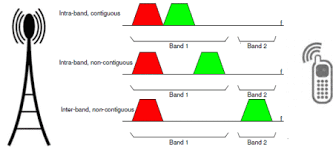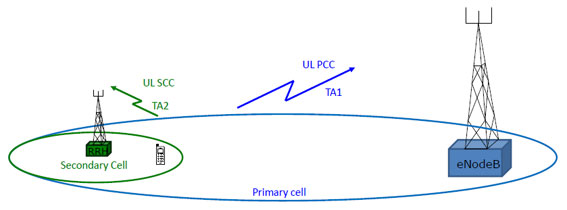
© copyright telecomabc.com

© copyright 3gpp.org
In a 4G-LTE environment a user will be allocated a channel through which the data upload or download is executed. To increase the data rate for the given user there are only two options namely, widen the channel or combine channels. This latter option is available in 4G+ and called carrier aggregation. Channels, or component carriers will be of size 1.4, 3, 5, 10, 15 or 20MHz and can be combined in up to 5 channels, so 100MHz is the widest possible, although a bit unrealistic. Remember that the 2.6GHz 4G licenses in the UK were allocated in 35MHz blocks
- Another channel - add another channel within the same bandwidth for the user's data transfer. This effectively doubles the space available to that user. But as these channels are not continuous there is some overhead in delivering the data this way. The MNO has to manage the data between the two separate blocks.
- Contiguous channel - Allow the user access to the space at one side of the current allocation. So if the user has 5MHz they will then have a contiguous allocation of 10Mhz. And there is no requirement for space between the two channels so effectively a single 10MHz channel. This is called channel bonding.
- We can also link one channel in one bandwidth with another in a second bandwidth. So the user will be using two different bandwidths to send or receive data. To achieve this there will be two (or more) serving cells for the data transmission. The data will take a different path. One of the cells is labelled the primary cell and it is used to manage the data from the other secondary cells. Whilst this may cause some overhead it does allow the MNO to share traffic between all their available bandwidth.
Note that different carrier aggregation can be implemented on the up and down links min order to make best use of the available bandwidth
With these basics quite complex carrier aggregation can be used. For the operator a large bandwidth makes this easier and more efficient. Currently the 4G (and 5G) bandwidth allocated to operators is small and spread over various bandwidths making carrier aggregation both difficult and necessary. THREE, with their purchase of UKBroadband managed to acquire a significant amount of contiguous bandwidth and thus making their bandwidth management through carrier aggregation simpler. OfCom is promoting some refactoring of broadband to give more contiguous space.
*u* ©mobilephonetechnology.co.uk all rights reserved 2017- 2025



